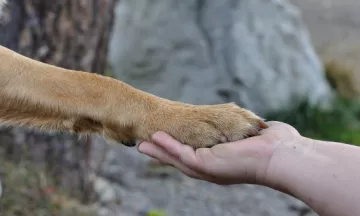Everyone knows that dogs require plenty of regular exercise. But how often should you walk your dog exactly and for how long? In this article, you’ll learn how much time you need to devote to your dog’s favourite pastime and what to expect from your dog sitting or dog walking service.
Dogs should be walked for a variety of different reasons - walkies enable them to:
- Go to the toilet
- Get some exercise
- Enjoy a good old sniff around
- Interact with other dogs

Doggy Business
One of the main reasons that we walk our dogs is to enable them to do their 'business’. Healthy, adult dogs should be let out at least 3 (and preferably 4) times a day. Puppies that are not yet fully house trained or older dogs suffering from incontinence problems typically require shorter, more frequent walks.
However, dogs don’t only pee to 'relieve themselves'; they also do it to leave a ‘scent trail’. Peeing is, therefore a key element of your dog’s walk. Your dog uses pee to mark their territory and communicate with other animals. So, allow your dog plenty of time for sniffing, as well as the freedom to determine where (within reason) they choose to pee.
Dogs obviously need to poop on a regular basis too. However, many dogs clock up significant 'mileage' before being ready to empty their bowels. So, don’t expect your dog to do everything during a short, 5-minute power walk around the block - give your dog enough time to find a suitable spot. Most dogs don’t like doing their business in their own garden or street, and prefer to choose somewhere a little further afield. Take a leisurely stroll to a preferred dog walking area and allow your dog to poo in peace. And don’t forget to bring your poo bags, so that you can clean up after your pampered pooch :-)
Exercise
How much physical exercise a dog requires depends on age and breed, and also varies between individual dogs. Puppies, for example, need to be walked more frequently (every 2 hours). They typically require shorter walks that might not see you making it to the end of your street. An active adult Viszla, Retriever or Border Collie, on the other hand, may require 3 walks per day. These should involve longer jaunts of up to 1.5 hours and incorporate lots of mental ‘work’, exercise and playtime.
Old or ill dogs require less physical exercise, yet still need mental stimulation. A quiet potter around the local park or a short, gentle stroll in local bushland will enable your poorly or senior dog to enjoy the great outdoors without becoming over-tired.
A good old sniff
If you’re particularly pressed for time, your dog’s insistence on sniffing anything and everything can sometimes prove frustrating. However, sufficient sniffing time is extremely important for your dog’s well-being. Sniffing enables your dog to process a considerable amount of information about the surrounding environment. So, make sure that you allow plenty of time for a good old sniff around. That way, your dog will return home from the walk feeling thoroughly satisfied and will be much calmer as a result.
Interaction with others
A walk also offers your dog an eagerly anticipated opportunity to play with other dogs. Social contact is extremely important for the majority of dogs, so (provided both dogs are willing) encourage your dog to kick back and enjoy a fun play-session with some four-legged friends. Read how to ensure that your dog plays safely here.
How do you know if your dog’s walks are long/frequent enough?
Dogs that are given opportunities to release their energy tend to exhibit calm and relaxed behaviour at home. If your dog doesn’t listen, appears restless and constantly demands attention, then there’s a good chance they haven’t enjoyed sufficient outdoor exercise. Which means that it’s time to tear yourself away from whatever it is that you’re doing and hit the road with your little tail-wagger. And, give your dog time to fully indulge their passion for running, sniffing and playing!
Is your faithful friend piling on weight? Then this could be an indication that he or she is not receiving sufficient exercise. Improve your dog's physical health with a more challenging walk. However, do make sure that you increase their exercise regime gradually (by adding 10 minutes to each walk, for example), rather than immediately embarking upon a 1.5-hour marathon.
Pet sitters and dog walkers
If you’re a dog sitter who additionally offers a dog walking service, then it’s important to communicate your dog walking regime with the owner in advance. Discuss the personal requirements of each individual dog, taking their breed, age and physical condition into account. And make sure that the length and frequency of the dog’s walks is clearly agreed by both parties up-front. Read what to discuss during the meet & greet here.
Need some extra dog walking help, love and cuddles for your dog? Find a dog sitter





